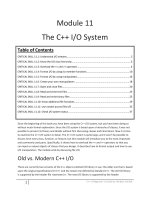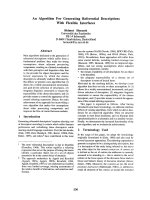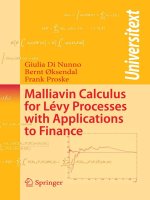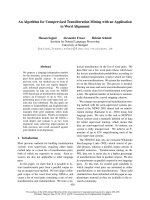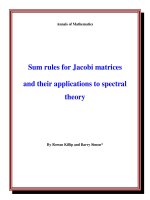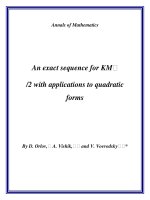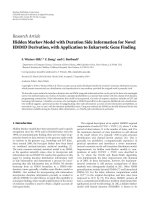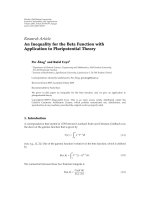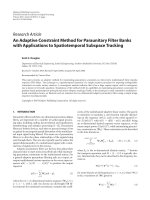I o efficient algorithm for constrained delaunay triangulation with applications to proximity search
Bạn đang xem bản rút gọn của tài liệu. Xem và tải ngay bản đầy đủ của tài liệu tại đây (2.86 MB, 90 trang )
I/O-EFFICIENT ALGORITHM FOR CONSTRAINED
DELAUNAY TRIANGULATION WITH
APPLICATIONS TO PROXIMITY SEARCH
XINYU WU
A THESIS SUBMITTED
FOR THE DEGREE OF MASTER IN COMPUTER SCIENCE
SCHOOL OF COMPUTING
NATIONAL UNIVERSITY OF SINGAPORE
2004
ii
Acknowledgement
Although only one name appears on the cover, this thesis would not be possible
without support of various people who accompanied me during last two and a half
years. I take this opportunity to express my thanks to all of them.
First and foremost, I would like to express my sincere gratitude to Dr. David
Hsu and Dr. Anthony Tung for their guidance, encouragement, and friendship
throughout my time as master candidature. As my supervisors, they have constantly motivated me to explore new knowledge and reminded me to remain focusing on achieving my main goal as well. Dr. Tung initiated the idea of using
the constrained Delaunay triangulation to facilitate obstructed proximity search
and introduced me to this exciting research direction. During my study, I enjoyed
numerous memorable conversations with Dr. Hsu. Without his insightful observations and comments, this thesis would never have been completed. But more
importantly, I want to thank my supervisors for teaching me the values of persistence, discipline and priority. These lessons will benefit me for the rest of my
life.
I am grateful to Huang Weihua, Henry Chia, Yang Rui, Yao Zhen, Cui Bin,
iii
and all other friends and colleagues in the TA office and Database group for their
friendship and willing to help in various ways. Working with them has certainly
been a wonderful experience. Further, I want to thank the university for providing
me with world-class facilities and resources.
My special thanks go to my beloved family in China for being supportive to
every decision I made.
Finally, my wife Liu Li helped me with most of the real-life data sets used in
the experiments. But that is the least thing I want to thank her for. I will have
to devote my whole life to repaying her unconditional love, understanding, and
support.
CONTENTS
Acknowledgement
ii
Abstract
ix
1 Introduction
1
1.1
Motivation . . . . . . . . . . . . . . . . . . . . . . . . . . . . . . . .
1
1.2
Objectives and Contributions . . . . . . . . . . . . . . . . . . . . .
6
1.3
Outline . . . . . . . . . . . . . . . . . . . . . . . . . . . . . . . . . .
7
2 Previous Work
9
2.1
Main Memory DT/CDT Algorithms
. . . . . . . . . . . . . . . . .
9
2.2
DT/CDT Algorithms in Other Computational Models . . . . . . . .
13
2.3
Obstructed Proximity Search Problem . . . . . . . . . . . . . . . .
18
3 External-Memory Constrained Delaunay Triangulation
25
3.1
Introduction . . . . . . . . . . . . . . . . . . . . . . . . . . . . . . .
25
3.2
Preliminaries . . . . . . . . . . . . . . . . . . . . . . . . . . . . . .
26
iv
v
3.3
3.4
3.5
3.6
Disk Based Method . . . . . . . . . . . . . . . . . . . . . . . . . . .
28
3.3.1
Overview . . . . . . . . . . . . . . . . . . . . . . . . . . . .
28
3.3.2
Computing the Delaunay Triangulation . . . . . . . . . . . .
29
3.3.3
Inserting Constraint Segments . . . . . . . . . . . . . . . . .
34
3.3.4
Removing Triangles in Polygonal Holes . . . . . . . . . . . .
38
Implementation . . . . . . . . . . . . . . . . . . . . . . . . . . . . .
38
3.4.1
Divide and Conquer . . . . . . . . . . . . . . . . . . . . . .
39
3.4.2
Merge and Conform
. . . . . . . . . . . . . . . . . . . . . .
42
Experimental Evaluation . . . . . . . . . . . . . . . . . . . . . . . .
45
3.5.1
Delaunay Triangulation
. . . . . . . . . . . . . . . . . . . .
46
3.5.2
Constrained Delaunay Triangulation . . . . . . . . . . . . .
50
Discussion . . . . . . . . . . . . . . . . . . . . . . . . . . . . . . . .
54
4 Obstructed Proximity Search
55
4.1
Introduction . . . . . . . . . . . . . . . . . . . . . . . . . . . . . . .
55
4.2
Experimental Evaluation . . . . . . . . . . . . . . . . . . . . . . . .
57
4.3
Obstructed Proximity Search Queries . . . . . . . . . . . . . . . . .
63
4.3.1
Obstructed Range Query . . . . . . . . . . . . . . . . . . . .
64
4.3.2
Obstructed k-Nearest-Neighbors Query . . . . . . . . . . . .
70
5 Conclusion
72
5.1
Summary of Main Results . . . . . . . . . . . . . . . . . . . . . . .
73
5.2
Future Work . . . . . . . . . . . . . . . . . . . . . . . . . . . . . . .
73
LIST OF FIGURES
1.1
A set of points (left) and its Delaunay triangulation (right). . . . .
1.2
A terrain surface constructed using Delaunay-based spatial interpolation. . . . . . . . . . . . . . . . . . . . . . . . . . . . . . . . . . .
1.3
2
3
Input data points and constraint edges (left) and the corresponding
Delaunay triangulation (right). . . . . . . . . . . . . . . . . . . . .
4
2.1
The rising bubble. . . . . . . . . . . . . . . . . . . . . . . . . . . . .
12
2.2
a diamond shape. . . . . . . . . . . . . . . . . . . . . . . . . . . . .
16
2.3
A set of polygonal obstacles (left) and the visibility graph (right). .
19
3.1
the triangle
pqr fails the in-circle test in the unconstrained case
because s lies in the interior of its circumcircle. In the constrained
case,
3.2
pqr survives the test as s is not visible to the its vertices. . .
27
Example of CDT of the open space. Triangles inside the holes are
deleted. . . . . . . . . . . . . . . . . . . . . . . . . . . . . . . . . .
vi
27
vii
3.3
The dividing step: partition the input PSLG into blocks of roughly
equal size so that each fits into the memory. In the zoomed-in picture, small circles indicate Steiner points created at the intersections
of input segments and block boundaries. . . . . . . . . . . . . . . .
3.4
The conquering step: compute DT in each block. The triangle t1 is
safe, and both t2 and t3 are unsafe. . . . . . . . . . . . . . . . . . .
3.5
31
The merging step: compute the DT of the seam. After merging Bi
and Bj , t2 becomes invalid and is deleted, but t3 remains valid. . . .
3.6
30
33
The DT of input data points. There are three types of triangles: triangles in light shade are the safe triangles obtained in the conquering
step; triangles in dark shade are the valid unsafe triangles that are
preserved during the merging step; the rest are crossing triangles. .
3.7
Inserting constraint segment pq only requires re-triangulating grey
region consisting of triangles intersecting with pq. . . . . . . . . . .
3.8
35
36
The conforming step: insert constraint segments Ki from Bi and
update the triangulation.
. . . . . . . . . . . . . . . . . . . . . . .
37
The final CDT of the input PSLG. . . . . . . . . . . . . . . . . . .
37
3.10 The final CDT of the input PSLG. . . . . . . . . . . . . . . . . . .
39
3.11 Data distributions for testing DT. . . . . . . . . . . . . . . . . . . .
47
3.9
3.12 Running time and I/O cost comparison of DT algorithms on three
data distributions. . . . . . . . . . . . . . . . . . . . . . . . . . . .
48
3.13 Comparison of our algorithm with a provably-good external-memory
DT algorithm.
. . . . . . . . . . . . . . . . . . . . . . . . . . . . .
50
3.14 Examples of generated PSLGs using different distributions. . . . . .
50
3.15 Running time and I/O cost comparison of CDT algorithms on three
data distributions. . . . . . . . . . . . . . . . . . . . . . . . . . . .
52
viii
3.16 Comparison between Triangle and our algorithm on Kuzmin PSLGs
with different segments/points ratios. . . . . . . . . . . . . . . . . .
53
4.1
Indonesian Archipelago . . . . . . . . . . . . . . . . . . . . . . . . .
57
4.2
Data Set 1: (a) a group of islands; (b) The visibility graph; (c) The
CDT of the open space; (d) An SSSP tree rooted at an input vertex
based on the visibility graph; and (e) the SSSP tree rooted at the
same vertex based on the CDT. . . . . . . . . . . . . . . . . . . . .
59
4.3
Data Set 2. . . . . . . . . . . . . . . . . . . . . . . . . . . . . . . .
60
4.4
Data Set 3. . . . . . . . . . . . . . . . . . . . . . . . . . . . . . . .
61
4.5
The approximation ratio for the three data sets . . . . . . . . . . .
62
4.6
Obstacle o having all its vertices out of rt CDT distance range still
affects the geodesic path.
. . . . . . . . . . . . . . . . . . . . . . .
66
4.7
x1 x2 is shorter than half the total length of paths A and B . . . . .
67
4.8
The shortest geodesic path (solid) and a shorter path that cuts
through the removed obstacle (dotted) . . . . . . . . . . . . . . . .
68
ix
Abstract
Delaunay Triangulation (DT) and its extension Constrained Delaunay Triangulation (CDT) are spatial data structures that have wide applications in spatial data
processing. Our recent survey, however, shows that there is a surprising lack of
I/O-efficient algorithms for computing DT/CDT on large spatial databases. In
view of this, we propose an external-memory algorithm for computing CDT on
spatial databases with DT being computed as a special instances.
Our proposal is based on the divide and conquer paradigm which compute
DT/CDT of in-memory partitions before merging them into the final result. This
is made possible by discovering mathematical properties that precisely characterize
the set of triangles that are involved in the merging step. Extensive experiments
show that our algorithm outperforms another provably good external-memory algorithm by roughly an order of magnitude when computing DT. For CDT, which has
no known external-memory algorithm, we show experimentally that our algorithm
scale up well for large databases with size in the range of gigabytes.
Obstructed proximity search has recently attracted much attention from the
spatial database community due to its wide applications. One main difficulty for
x
processing obstructed proximity search queries lies in how to prune irrelevant data
effectively to limit the search space. The performance of the existing pruning
strategies is unsatisfactory for many applications. We propose a novel solution
based on the spanner graph property of the CDT to address this key weakness. In
particular, we show how our pruning strategy can be used to process the obstructed
k-nearest-neighbors and range queries.
1
CHAPTER 1
Introduction
In this thesis we present an I/O-efficient algorithm for construction of large-scale
constrained Delaunay triangulations. We also propose effective methods based on
the constrained Delaunay triangulation for processing obstructed proximity search
queries in spatial database systems.
1.1
Motivation
Delaunay triangulation (DT) is a geometric data structure that has been studied
extensively in many areas of computer science. A triangulation of a planar point
set S is a partition of a region of the plane into non-overlapping triangles with
vertices all in S. A Delaunay triangulation has the additional nice property that it
tends to avoid long, skinny triangles, which lead to bad performance in applications
(Figure 1.1). In this work, we develop an efficient algorithm that computes DT and
its extension, constrained Delaunay triangulation, for data sets that are too large
2
p2
p1
p2
p1
p3
p3
p4
p4
p5
p5
p6
p6
p8
p8
p7
p7
p10
p9
p10
p12
p9
p12
p11
p11
p13
p13
p15
p14
p17
p15
p16
p14
p17
p16
Figure 1.1: A set of points (left) and its Delaunay triangulation (right).
to fit in the memory.
DT is an important tool for spatial data processing:
Spatial data interpolation. In geographical information systems (GIS), a common task is terrain modelling from measurements of the terrain height at
sampled points. One way for constructing a terrain surface is to first compute the DT of the sample points and then interpolate the data based on the
triangulation [22, 23, 37]. Figure 1.2 shows a terrain surface constructed this
way. The same interpolation method easily extends to other spatial data,
such as readings from a sensor network.
Mesh generation. Many physical phenomena in science and engineering are modelled by partial differential equations, e.g., fluid flow or wave propagation.
These equations are usually too complex to have closed form solutions, and
need numerical methods such as finite element analysis to approximate the
solution on a mesh. DT is a preferred method for mesh generation [1]. As an
example, in the Quake project, finite element analysis is applied to billions of
points to simulate the shock wave of earthquakes, and DT is used to generate
3
Figure 1.2: A terrain surface constructed using Delaunay-based spatial interpolation.
the meshes needed for simulation [3].
Proximity search. Voronoi diagram is an efficient data structure for nearest
neighbor search. Since the DT of a point set is in fact the dual graph of
the corresponding Voronoi diagram [7, 37] and is easier to compute, it is
common to compute the DT first and obtain the Voronoi diagram by taking
the dual.
The application of DT extends further if we allow in the input data constraint
edges that must be present in the final triagulation. Intuitively, this extension,
called the constrained Delaunay triangulation (CDT), is as close as one can get to
the DT, given the constraint edges (Figure 1.3). Constraint edges occur naturally
in many applications. We give two representative examples. In spatial data interpolation, allowing constraint edges helps to incorporate domain knowledge into the
triangulation. For example, if the data points represent locations where pedestrian
traffic flow is measured, the constraint line segments and polygons may represent
obstacles to the pedestrians. It therefore makes sense to interpolate “around” the
obstacles rather than through them. Likewise, in mesh generation for finite element analysis, constraint edges mark the boundaries between different mediums,
4
p2
p1
p2
p1
p3
p3
p4
p4
p5
p5
p6
p6
p8
p8
p7
p7
p10
p9
p10
p12
p9
p12
p11
p11
p13
p13
p15
p14
p17
p15
p16
p14
p17
p16
Figure 1.3: Input data points and constraint edges (left) and the corresponding
Delaunay triangulation (right).
e.g., regions where water cannot flow through.
The importance of DT and CDT to applications has led to intensive research.
Many efficient DT algorithms have been proposed, and they follow three main approaches: divide-and-conquer, incremental construction, and plane sweep [7, 8]. Of
the three approaches, the first two are also applicable to CDT, as well. Unfortunately, although many applications of DT and CDT involve massive data sets,
most algorithms assume that the input data is small enough to fit entirely in the
memory, and their performance degrades drastically when this assumption breaks
down.
If the input data do not fit into the memory, incremental construction is unlikely
to be efficient, because a newly-inserted point may affect the entire triangulation
and results in many I/O operations. The only remaining option is then divideand-conquer. The basic idea is to divide the data into blocks, triangulate the data
in each block separately, and then merge the triangulations in all the blocks by
“stitching” them together along the block boundaries. The key challenge here is
to devise a merging method that is efficient in both computational time and I/O
5
performance, when the whole triangulation can not fit in the memory completely.
One of our motivations for designing large-scale CDT algorithm is to facilitate
obstructed proximity search. Despite the presence of obstacles in many applications, most traditional spatial proximity search queries, such as k-nearest-neighbors
and range queries, measure the distance using simple metric, e.g., the L1 distance or
Euclidean distance. The advantage of adopting these simple metrics is the computational efficiency. However, many real-life scenarios cannot be modelled accurately
by these simple metrics due to the blocking of obstacles. For example, a nearest gas
station under the Euclidean metric may not mean so much to a car driver if it is
across the river. Obstructed proximity search queries addresses this inaccuracy by
measuring, between two points, the length of the shortest obstacle-avoiding path.
In the literature, this length is often called the geodesic distance, and the shortest obstacle-avoiding path the shortest geodesic path. The obstructed proximity
search queries have wide applications in geographical information systems, facility
location planning, and virtual environment walk-through. In addition, they can
also serve as a useful tool for spatial data mining algorithms such as clustering and
classification [41].
Because of its importance, obstructed proximity search queries have recently
attracted a lot of attention from the spatial database community [44, 45]. The basic operation of all obstructed proximity search is to compute the shortest geodesic
path. This can be done by constructing and searching the so-called visibility graph.
Unfortunately the visibility graph has super-quadratic complexity in both time and
space and therefore cannot be pre-materialized. One way to circumvent this is to
prune irrelevant data and build local visibility graph online. However, the existing
pruning strategies are often not effective enough and result in great computational
waste in computing local visibility graph. The need to design better pruning strat-
6
egy is becoming more and more apparent.
1.2
Objectives and Contributions
Motivated by the observation that there is limited work on practical algorithms for
external-memory DT and CDT despite their importance, the first objective of this
thesis is to design a scalable method for the construction of CDT, with DT as a
special case. We believe that our work makes the following contributions:
• We present an efficient external-memory algorithm for CDT using the divideand-conquer approach (Section 3.3). We give a precise characterization of
the set of triangles involved in merging, leading to an efficient method for
merging triangulations in separate blocks. Our algorithm makes use of an
internal-memory algorithm for triangulation within a block, but the merging
method is independent of the specific internal-memory algorithm used. In
this sense, we can convert any internal-memory DT/CDT algorithm into an
external-memory one, using our approach.
• We describe in details the implementation of our algorithm (Section 3.4).
One interesting aspect of our implementation is that after computing the triangulation in each block and identifying the triangles involved in merging,
we can merge the triangulations using only sorting and standard set operations and maintain no explicit topological information. These operations are
easily implementable in a relational database. They require no floating-point
calculation, thus improving the robustness of the algorithm.
• We have performed extensive experiments to test the scalability of our algorithm for both DT and CDT (Section 3.5). For DT, we compare our algorithm
7
with an existing external-memory algorithm that is provably good, and show
that our algorithm is faster by roughly an order of magnitude. For CDT,
to our knowledge, there is no implemented external-memory algorithm. We
compare the performance of our algorithm with an award-winning internalmemory algorithm [39] and show that the performance of our algorithm degrades much more gently when the data size increases.
The second objective of this thesis is to improve the efficiency of processing
obstructed proximity search queries. The main problem of such queries is how
to prune irrelevant data effectively to limit the size of the local visibility graph.
The existing pruning strategy is not powerful enough for many applications. We
present a more effective solution based on the spanner graph property of the CDT
(Section 2.3). Our contribution towards the second objective are the following:
• We have conducted extensive experiments on real-life data set to examine
the true stretch factor of the CDT as spanner graph of the visibility graph
(Section 4.2). Our experiment lends support to the general belief that the
CDT indeed approximates the visibility graph significantly better than the
theoretically proven bound.
• We introduce a provably good pruning strategy based on CDT for processing
obstructed proximity search queries. In particular, we apply our strategy
successfully to k-nearest-neighbors and range queries (Section 4.3).
1.3
Outline
The remaining of the thesis is organized as follows: Chapter 2 is a literature review of the previous work in DT/CDT construction algorithms and the obstructed
8
proximity search problem; In Chapter 3, we present our external-memory CDT
algorithm in detail and provide extensive experimental evaluation of its performance. In Chapter 4, we first examine the stretch factor of CDT as the spanner
graph through experiments on real-life data sets, and then propose a new pruning
strategy for processing obstructed proximity search queries. Chapter 5 concludes
our work with a summary of the main results and suggests directions for future
research.
9
CHAPTER 2
Previous Work
Due to its importance for applications, DT has received much attention. Intensive
research has led to many efficient algorithms, using various approaches. In this
chapter, we review some of the current main memory, external-memory and parallel
algorithms for computing DT and CDT. Also found in this chapter is a brief survey
of the proximity search problem in the presence of obstacles.
2.1
Main Memory DT/CDT Algorithms
Efficient main memory algorithms for computing DT have been discovered for a long
time. Three types of commonly used algorithms are divide-and-conquer algorithms,
plane sweep algorithms and incremental algorithms. The divide-and-conquer approach recursively divides the input data into roughly equal parts, computes the
triangulation for each part, and then merge the resulting triangulations. The plane
sweep approach sorts the data according to their x-coordinates and processes the
10
data from left to right in the sorted order [21]. The randomized incremental construction processes the input data vertices one by one and updates the triangulation
when a data vertices is inserted [31]. See [8] for a good survey. Many of these
algorithms achieve the O(n log n) running time, which is optimal asymptotically.
n is the number of input vertices.
Experiments show that of the three approaches, divide-and-conquer is the most
efficient and robust one in practice [40]. Although the external-memory algorithm
we propose follows a different design principle of minimizing disk I/O, it is also
based on the divide-and-conquer paradigm and therefore share certain common
characteristics with the main memory divide-and-conquer approach. We discuss
the main memory divide-and-conquer approach in some depth here.
Shamos and Hoey [38] found a divide-and-conquer algorithm for computing
Voronoi diagram, based on which DT can be easily built as it is the dual graph
to Voronoi diagram. Lee and Schachter [34] first gave a divide-and-conquer algorithm directly constructing DT. Nevertheless, their original algorithm and proof are
rather intricate, and Guibas and Stolfi [25] introduced an ideal data structure to
fill out many tricky details. The original algorithm partitions the data into vertical
strips. Dwyer [18] provided a simple yet effective optimization by alternating vertical and horizontal cuts to partition the data into cells of size O(log n) and merging
DT of cells first into vertical strips and stitching strips into the whole triangulation. The optimized algorithm achieves better asymptotic performance on some
distributions of vertices and runs faster in practice as well. Inspired by Dwyer’s
idea, our external-memory algorithm also partitions the data with alternating cuts,
though the cell size is determined by other factors.
The central step of the divide-and-conquer algorithm is to merge two half triangulations, here denoted by L and R, into the whole triangulation. Firstly, the
11
lower common tangent e1 of L and R is found. e1 must be in DT, as we can always
construct an empty circle pertaining to cord e1 by starting with any such circle and
growing it away from the triangulation. e1 is the first edge crossing the separating
line between L and R. Inductively suppose that ei is the i-th cross edge and all the
cross edges below ei are correctly constructed. If ei is the upper common tangent
of L and R, then the merging step is finished. Otherwise we can imagine growing
an empty cycle pertaining to cord ei upwards until it touches the first vertex v,
referring to Figure 2.1. It can be shown that v must be connected to the end of
ei that lies on the same side of v. The algorithm then creates a new cross edge
ei+1 connecting v with the other end of ei . All the original edges in triangulations
of L and R that cross ei+1 are deleted. The merging step works from bottom up
until the upper common tangent is met. As one might expect, the algorithm has
to store some connectivity information like pointers from an edge to its incident
edges [25] or from a triangle to its incident triangles [39] so that the updates can
be efficiently performed.
Lee and Lin [33] first investigated the CDT and proposed an O(n2 ) algorithm
for its construction. Later, Chew [13] described a divide-and-conquer algorithm
that reduced the time bound to asymptotically optimal O(n log n), n being the
number of vertices. The algorithm is however very demanding to implement. The
most popular and probably the easiest to implement algorithm for constructing
constrained CDT is the incremental algorithm [4, 20, 42]. An incremental CDT
algorithm first computes DT of the input point set. Then the segments are inserted in to the triangulation. Each insertion of the segment may affect a certain
region in the triangulation. Specifically, the region comprises all the triangles that
cross the segment. As the segment must be included in the CDT, all the edges
crossing the segment are removed. The affected region is hence cut by the segment
12
ei
R
L
Figure 2.1: The rising bubble.
into two sub-regions. It can be shown that only these two sub-regions need to be
re-triangulated to conform the triangulation to the segment. The complexity of an
insertion includes two parts. The first part is to locate the affected region. Theoretically, one can build a O(n) index structure to answer location queries in O(log n)
time. However, this does not usually work well in practice due to preprocessing
and storage requirements. One practical solution is the jump-and-walk algorithm
proposed by M¨
ucke et al. [36]. The second step is to re-triangulate the affected
region. Wang [42] discovered a difficult algorithm that runs in asymptotically optimal O(k) time, k being the number of vertices of the affected region. k is normally
a small number unless the segment is very long, and a simple O(k 2 ) algorithm [20]
is usually adopted in practice.
13
2.2
DT/CDT Algorithms in Other Computational
Models
The algorithms listed above all assume a sequential random access model of computation and do not consider the efficiency with respect to disk access. When the
data is too massive to fit into the memory, they completely rely on the virtual
memory of the OS and perform poorly due to huge amount of I/O operations.
The situation is even worse for constrained DT. As in the conventional incremental
algorithm, each insertion of the segment involves a location query which is very
expensive when the triangulation is stored on disk. In this section, we survey the
external-memory algorithms for constructing DT.
Another class of DT algorithms that caught our attention are parallel algorithms. We discuss parallel algorithms because they share similar design principles
with the external-memory algorithm and many techniques used in parallel algorithms can be easily extended to external-memory algorithm or vice versa.
External-Memory Algorithms
The memory of a modern computer system is typically organized into a hierarchy.
From top to bottom, we have CPU registers, L1 cache, L2 cache, main memory,
and disc. Each level is faster, smaller, and more expensive per byte than the next
level. For large-scale information-processing applications, the I/O communication
between fast main memory and slower external storage devices such as disks and
CD-ROMs often forms the bottle-neck of the overall execution. In this context,
a theoretical simplified memory hierarchy was proposed to analyze the program
performance [24]. In this model, there are only two kinds of memory: the very fast
main memory and the very slow disk. A disk is divided into contiguous blocks.
14
The size of each block is B; The size of the problem instance is N ; and the size of
the memory is M . For the purpose of analyzing external-memory algorithm, M is
assumed to be smaller than N . All the I/O-efficient DT algorithms that we know
are designed based on this model. However, before we survey these algorithms we
need to stress two limitations of this model. Firstly, the model assumes a unit cost
for accessing any block of data in disk and does not consider the fact that reading
contiguous blocks is typically much cheaper than random reads. Secondly, the I/O
analysis done under this model often focuses too much on asymptotical bound in
terms of M and N and neglects the hidden constant factor. Thus an asymptotically
optimal algorithms may not yield good practical performance.
In [24], Goodrich et al.. introduced several I/O-efficient algorithms for solving large scale geometric problems. They described an algorithm for solving the
3-d convex hull problem with an I/O bound of O((N/B) logM/B (N/B)). By wellknown reductions [9], the algorithm can also be used to solve DT problem with
the same I/O performance, which is asymptotically optimal. However, the algorithm is “esoteric” as they described. Crauser et al.. developed a new paradigm
based on gradation for optimal geometric computation using external-memory and
achieved the same optimal I/O bound for DT construction [16]. Both algorithms
presented in [24] and [9] are cache-aware in the sense that they need to know the
parameters M and B in advance. Subsequently, Piyush and Ramos [30] studied the
cache-oblivious version of DT construction, where the algorithm only assumes an
optimal replacement strategy to decide which block is to be evicted from internal
memory instead of the actual values of M and B. Moreover, they implemented a
simplified version of their algorithm and reported the running time of their program. That is the only experimental study of an external-memory DT algorithm
that we have found in the literature. All the above algorithms are based on random
15
sampling. For a concrete example, we summarize the algorithm Piyush and Ramos
implemented in [30] below.
The algorithm adopts a divide-and-conquer approach. Given the input of n
vertices, it first draws a random sample of the vertices that is small enough to fit
into the memory and computes DT of the sample using any efficient main memory
algorithm. For convenience, the sample actually includes 4 points in infinity so that
the triangulation covers the whole space. Then the algorithm computes the conflict
list of each triangle in DT of the sampled vertices. The conflict list of a triangle
is the set of all vertices that invalidates the triangle, that is, the set of all vertices
that lie within the circumcircle of the triangle. For each pair of triangles in the
sample that share a common edge, connect the two common vertices together with
the circumcenters of the two triangles to form a diamond. See Figure 2.2. It is easy
to see that all such diamonds form a partition of the space, therefore any triangle
in the final triangulation of the whole vertices set must has its circumcenter in one
of those diamonds, ignoring the case where the circumcenter lies on the boundary
between diamonds for brevity. So in the conquering step, the algorithm finds all
the triangles circumcentered in each diamond. To do this, the algorithm loads all
the vertices in the union of the conflict lists of the two triangles that define the
diamond, calls a main memory algorithm to compute DT of these vertices, and
scan from the triangulation for triangles circumcentered in the diamond. It can
be shown that these triangles are precisely those in the overall triangulation whose
circumcenters lie in the diamond.
Note that in the conquering step, one cannot be theoretically certain that the
vertices from the union of conflict lists fit into the memory. At best, one can
argue this is the case with high probability. As experiments demonstrate, it is
good enough for practical purposes. There are two sources of inefficiency in the
